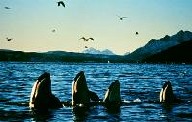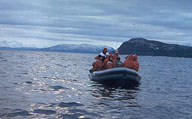Descending through the clouds I was shocked out of my artificial aircraft-cabin-induced comfort by the bleak snow-covered wilderness of Norway’s fjords and impressive coastline. The orange glow on the horizon was a reminder that we were north of the Arctic Circle and that despite the hour, a little after two in the afternoon, darkness would soon be upon the land. The landscape below looked impressive but above all cold and I was filled with trepidation about my forthcoming encounter with killer whales, especially as I intended to get into the water with them. Was I mad? Was I really about to do this? And yet some twenty-four hours later, emerging from the icy water, having just confronted the whales in their own territory, I was of a very different frame of my mind.
The journey from England is long and protracted, which is perhaps why Tysfjord, our base for the next few days, retains much of its charm and has been spared the ravages of invasive tourists. A two hour flight took me to the modern efficiency of Oslo airport and from there a further short flight took me north of the Arctic Circle. Here we were met in the fading light and driven two hours to Skarberget before taking a twenty-five minute ferry ride to Storjord. It had been a long and tiring journey and I was glad when we finally arrived at our destination, Tysjord Turistsenter, and able to enjoy it’s welcoming atmosphere and easy-going camaraderie, which soon dispelled my nervousness about the day ahead.
In the sober light of day (I use ‘light’ metaphorically rather than literally because as we were north of the Arctic circle it was still dark) my angst had returned. Yet in spite of my inner turmoil I managed a hearty breakfast, after which there was a most informative lecture about the orcas. A toothed whale, as opposed to a baleen whale, orcas are the most wide ranging mammal on earth, inhabiting all the seas of the world. As a result they have a wide and varied diet with some populations specialising on marine mammals, perhaps most dramatically the killer whales of Patagonia who beach themselves to pick off unsuspecting seals, and others specialising on fish, such as salmon in Canada and herring here in Norway. The herring gather in the waters of the fjords around Tysfjord to slow their metabolism for the winter season and the orcas follow them, each orca feeding on about 100kg, or about 250-300 fish, a day.
Duly briefed and with my anticipation, not least my trepidation, reaching new heights, it was time for the very necessary but light-hearted moment of getting kitted up for the day. With my thermals, inner suit, socks and dry suit on I felt not unlike ‘Michelin’ man, but more importantly I felt warm. But for how long?
A short drive took us to our waiting zodiac rubber boat, we clambered aboard and headed out into the fjords. Tysfjord, like all Norway’s fjords, was carved out by glaciers in the last Ice Age and is over 800 metres deep in places. Steep and narrow, it is dominated by the rugged beauty of the coastline, the mountains flanking its sides like a savage sea of frozen granite waves. Bouncing along in the zodiac, the icy mountains dominating on both sides, in my dry suit, with fins and mask at the ready, I was overwhelmed by a sense of boys-own adventure, feeling as if I was part of some SBS commando.
“There, there! Whale!” cried Rolf, our zodiac driver. In disbelief, as we had only been going for a few minutes and I had not expected to encounter whales quite so quickly, I scanned the sea in front of us and there indeed was the tall distinctive dorsal fin of an orca rising imperiously out of the sea for a few tantalising seconds before submerging. He – the dorsal fin of the male is tall and pointed, up to five foot in height, whereas the female’s is smaller and curved – was not alone. The sea came alive in a series of graceful arches and playful splashes as mother, fathers, youngsters, cousins and grandparents slipped through the water, the sunlight glistening on their fins.
Soon we were alongside them, thrilled at the spectacle unfolding all around us, cameras clicking continuously trying to capture the moment on film. Yet to do so is difficult as you do not know where they will surface next and in a moment the opportunity is gone. It is so easy to spend too long staring through a viewfinder to no avail and thus I thought it best to sit back and simply enjoy the majesty of their progress.
Or better still, “Can we get into the water with them?” I asked eagerly. “No they are travelling,” was Rolf’s patient reply. Scientists divide the behaviour of killer whales into four activities: hunting, social activities, resting and travelling. Norwegian killer whales are resident whales but move a lot within the fjord system searching for herring; in all they spend approximately 40% of their time travelling. Thus for the time being we had to wait and be content with seeing them all around us. Content! In those first few minutes I had seen more whales and at much closer quarters than in all my previous whale-watching experiences, and yet I wanted more.
What we were looking for was a pod that was feeding, as this was the only way that we would be able to stay close to the whales whilst in the water. The orcas of Tysfjord use a unique technique called “carousel feeding”, in which the whales work together to bring a school of herring close to the surface and then circle around the herring to panic them into a tighter and tighter ball. The whales then slap their massive tail flukes through the school so that the herring are stunned or killed and can be picked off at leisure.
We thus headed off towards an island called Bekkenshel as the water was not so deep here, being between 150 to 200 metres, which meant that the whales did not have to dive so deep to chase the herring to the surface. En route to Bekkenshel we were spoilt by the company of not just one but several pods. Although these pods were travelling like the first that we had seen, they seemed more playful, occasionally daring to jump out of the water revealing their distinctive black and white markings. They seemed more at ease with our boat some being only a few metres whilst others were so inquisitive as to our presence that they were “spyhopping”. As the term suggests, “spyhopping” is when the whales are eager to know what is on the surface and poke their heads vertically out of the water and have a good look around, almost like a meerkat standing sentry on the plains of southern Africa.
Eventually we came across a pod that was carousel feeding – the tell-tale signs of dead herring floating to the surface and of hundreds of gulls circling around the sky had led us to the ‘kill’. As I spat into my mask and readied myself to get into the water I tried to find solace in the fact that we had been told numerous times that the orcas in Tysfjord have only one thing on their mind: herring. I chanted “herring, herring” like some sort of mantra and dropped uneasily into the water.
Immediately my doubts and fears were washed aside. The dry suit did its job and after the initial shock of cold around my mouth I felt comfortable, if a little awkward, in the water. No sooner had I come to terms with my surrounds than a six-metre whale weighing in at around four tons glided effortlessly beneath me. Surprisingly I felt no sense of panic, rather the opposite, a remarkable calmness. The whale was totally unaffected, seemingly oblivious, to my presence and it is hard to be affected negatively by such a serene and trustful animal.
It was an undoubted honour and privilege to be in the watery domain of such a majestic creature, a creature that is a fascinating combination of forbidding strength, grace and high intelligence. Not only was it a thrill to be so close to such a powerful and potentially dangerous predator but it was so much more revealing than the fleeting glimpses that I had witnessed minutes before from the zodiac. Here I was able to see – visibility was good being some twenty metres – them at close quarters including one mother with her infant. Just when I thought that I’d seen the last of these wolves of the sea, in the form of a disappearing body and fading tail fluke, another would rocket from the deep to pause right alongside me, or float vertically in the water like a patrolling guard inspecting a possible intruder.
Every so often I would put my head above water to take in the scene about me. I had to pinch myself as all around me whales were breaking the surface, their dorsal fins proud, defiant and above all impressive - I can assure you that a five foot fin seems much bigger from the water than from the relative security of a zodiac. The sky above was a flurry of screaming gulls, squawking and squabbling noisily over the debris of the whales’ feeding. It seemed noisy, frenzied and frantic in comparison to the calm, controlled feeding below the surface.
After a while the feeding came to an end and we clambered back into the boat, excitedly exchanging experiences. Rolf nodded and smiled to himself as he headed off in search of another pod. We came across a large circular area of calm water which, later that day Tiu Simila, the leading researcher and orca expert in Norway, explained was caused by air bubbles coming from the herring – the herring change depth quickly to escape from predators such as the orcas and in so doing they release a gas that causes the bubbles. Getting in to the water there were indeed billions of tiny bubbles floating to the surface but unfortunately for the herring their tactic had not worked….
Beneath me an orca hung vertically in the water, a solitary sentry standing guard. All around me I could hear the communicative sonar clicks as other orcas stage-managed their impressive manoeuvre of corralling the herring but frustratingly I could see nothing apart from the one whale beneath me. Although events were taking place beyond my field of vision, I sensed with increasing excitement that something was about to happen. Then suddenly a mass of thousands of silvery fish shot forward swimming frantically for their lives. The orca unhurriedly and deliberately flicked her tail into the oncoming rush. The herring scattered.
However not all of the herring were so swift: an unlucky few floated lifelessly in the water before being gulped down by the orcas. I pulled my head out of the water, gasping for breath – I had been so engrossed and excited by the underwater hunt that I had forgotten to breathe. Gulping in the cold Arctic air, I felt truly exhilarated, ecstatic that I had just witnessed one of the most fascinating events in animal behaviour.
|
|
|














